

KL divergence or relative entropy Two pmfs p (x) and q (x) : p (x) log p (x) � (5) D( p � q ) = q (x) x ∈X q = 0 , otherwise p log p Say 0 log 0 0 = ∞ . � � log p (X) D( p � q ) = E p (6) q (X) I(X ; Y) = D( p (x, y) � p (x) p (y)) (7) 12
• Measure of how different two proba- bility distributions are • The average number of bits that are wasted by encoding events from a distribution p with a code based on a not-quite-right distribution q . • D( p � q ) ≥ 0 ; D( p � q ) = 0 iff p = q • Not a metric: not commutative, doesn’t satisfy triangle equality 13
[Slide on D(p � q) vs D(q � p) ] 14
Cross entropy • Entropy = uncertainty • Lower entropy = determining efficient codes = knowing the structure of the language = good measure of model quality • Entropy = measure of surprise • How surprised we are when w follows h is pointwise entropy: H(w | h) = − log 2 p (w | h) p (w | h) = 1 ? p (w | h) = 0 • Total surprise: n � H total = − log 2 m (w j | w 1 , w 2 , . . . , w j − 1 ) j = 1 = − log 2 m (w 1 , w 2 , . . . , w n ) 15
Formalizing through cross-entropy • Our model of language is q (x) . How good a model is it? • Idea: use D( p � q ) , where p is the correct model. • Problem: we don’t know p . • But we know roughly what it is like from a corpus • Cross entropy: H(X, q ) = H(X) + D( p � q ) (8) � = − p (x) log q (x) x 1 = E p ( log q (x)) (9) 16
• Cross entropy of a language L = (X i ) ∼ p (x) according to a model m : 1 � H(L, m ) = − lim p (x 1 n ) log m (x 1 n ) n →∞ n x 1 n • If the language is ‘nice’: 1 H(L, m ) = − lim n log m (x 1 n ) (10) n →∞ I.e., it’s just our average surprise for large n : H(L, m ) ≈ − 1 n log m (x 1 n ) (11) • Since H(L) is fixed if unknown, minimiz- ing cross-entropy is equivalent to minimiz- ing D( p � m ) • Providing: independent test data; assume L = (X i ) is stationary [does’t change over time], ergodic [doesn’t get stuck] 17
Entropy of English text 27 letter alphabet Model Cross entropy (bits) zeroth order 4.76 ( log 27 ) first order 4.03 second order 2.8 Shannon’s experiment 1.3 (1.34) 18
Perplexity perplexity (x 1 n , m ) = 2 H(x 1 n , m ) = m (x 1 n ) − 1 n 19
Recommend
More recommend